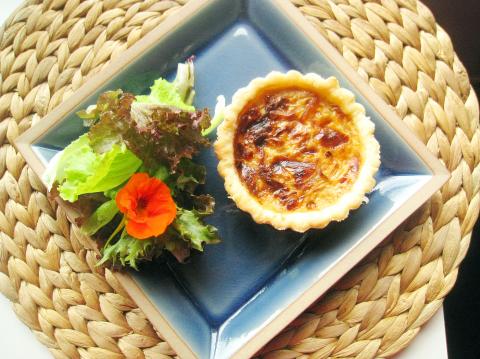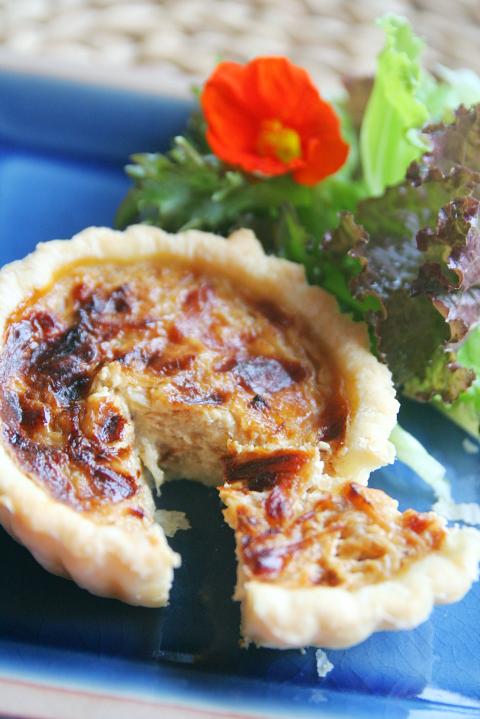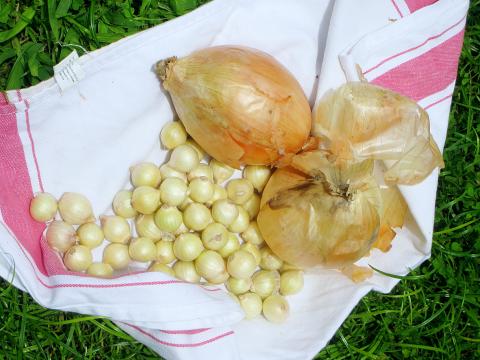Onions are so fundamental to cooking that they are often overshadowed by more exotic plants, but they are in fact remarkably tasty in their own right. The local onion season is drawing to a close, but there is still time to celebrate the fresh produce from Taiwan’s Hengchun peninsula, which are some of the finest you will find anywhere in the world. Purple and white onions are grown, but the most common, versatile and delicious is the simple brown onion. Bought fresh, these onions are bursting with juice and sweetness.
The use of onions for food, and even as a medicine, date back to an almost mystical past. The US National Onion Association, in a short article about the history of the onion, points to a date 5,000 years ago when it says most researchers agree that the onion was being cultivated, though suggests that the use of wild onions would date much further back. It became an integral part of many culinary traditions, and in ancient Egypt it was even regarded as an object of worship.
The pungency of onions may have been the reason for this exultation of an otherwise humble vegetable, with speculation that the Egyptians believed the strong scent indicated magical properties, or at least antiseptic ones, that would be beneficial in the afterlife. The Romans took a rather more down to earth approach to the benefits of onions. Gladiators are known to have rubbed themselves with onions to firm up their muscles (not something I’ve tried myself), but other medical lore related to the onion includes the belief that it could facilitate bowel movements and erections (hopefully not at the same time), relieve headaches, coughs, snakebite, hair loss and infertility.

Photo: Ian Bartholomew
The jury is still out on whether these beliefs hold any scientific truth, but doctors today are pretty much unanimous on the importance of onions, or other members of the Allium family to which it belongs, to a balanced diet. Multiple studies have shown that eating onions provide protection for the heart and blood vessels when consumed in a diet that is rich in other vegetables and fruits. Onions have also been shown to help increase bone density, particularly for the elderly. And of course, the pungent onion is also a fantastic anti-inflammatory, not to mention its powerful antioxidant effect. Basically, an onion a day will keep you healthier for longer.
Despite this, the onion has not always endeared itself to modern diners, who fear the lingering odor on their breath. The poet Jonathon Swift has pronounced on this issue, writing: “For this is every cook’s opinion, No savory dish without an onion; But lest your kissing should be spoiled, Your onions should be thoroughly boiled.”
Onions are amenable to all kinds of cooking methods, but the ones chosen for boiling or braising are generally of a smaller variety than Taiwan’s famous brown onions. Miniature pearl onions (see illustration) are grown in Taiwan, but can only occasionally be found in traditional markets. Boiling these in a mixture of butter, sugar and water to build a rich caramel flavor creates a wonderful side dish, and they are also a lovely addition to beef or pork braises.

Photo: Ian Bartholomew
The ubiquitous Taiwan brown onion is perfect as a base for all kinds of stews, and at its best and freshest can also be enjoyed raw. Sprinkle thinly sliced onions with salt and leave for 20 minutes, then squeeze out the liquid, drawing out the sharp flavors and retaining the sweetness. Toss with some tomatoes or flat leaf parsley, season and toss in olive oil, and you have a perfect refreshing side dish to complement a savory dish of meat or fish.
Depending on how you prepare them, onions are able to bring a wide range of different flavors to your food. Indeed, the onion is fundamental to Mediterranean cuisine and is important in many other cuisines around the world. No less a personage than Julia Child pronounced that it would be “hard to imagine civilization without onions.”
Apart from flavor, onions are very nutritious and also store and travel well. This has contributed further to their appeal across the globe.

Photo: Ian Bartholomew
Recipe for simple onion tart
(Makes 6 tartlets)
I find that tartlets, with their higher ratio of crust to filling, work perfectly with the rich creamy onion filling. It is vitally important to allow the onions to caramelize thoroughly, bringing out a complex sweetness that defines this simple dish.
Ingredients
For the pastry
220g plain flour
pinch of salt
130g butter, cubed
100ml cold water
For the filling
50g butter
500g small onions, (about 2 large), halved and finely sliced
2 eggs
1 cup (250ml) double cream
60g coarsely grated cheese (emmental or gruyere work well)
Directions
First make the pastry shells:
1. Weigh the butter then cut it into cubes. Place in the freezer for 5-10 minutes.
2. Place about 100ml of water in the freezer to chill.
3. Weigh out flour. When the butter is well chilled, mix lightly with flour then place in food processor and pulse until a course sandy texture is achieved. (Depending on the machine, this should take no more than about 5 seconds.)
4. Pour into a bowl, add half the water and mix quickly with a wooden spoon, adding more water (a very little at a time) as needed to help the mixture come together. The mixture should not become wet and tacky.
5. Roll into a ball then press into a disk. Wrap in plastic wrap and place in the fridge for at least 1 hour.
6. Generously butter six 8cm tart molds. Press the pastry into the molds, prick the base with a fork and chill well.
Then make the filling:
7. Melt butter in a large skillet or saute pan. Add onions and saute over medium heat until soft, sticky and brown. Allow to cool slightly.
8. In a separate bowl, add cheese, eggs and cream. Beat to combine and season with salt and pepper.
9. Add the warm onion to the cream mixture and mix well.
Put it all together:
10. Add to the chilled tart casings and bake for 30 minutes.
11. Remove from oven and allow to cool for 10 minutes.
Turn out onto a wire rack. Serve warm.
Ian Bartholomew runs Ian’s Table, a small guesthouse in Hualien. He has lived in Taiwan for many years writing about the food scene and has decided that until you look at farming, you know nothing about the food you eat. He can be contacted at Hualien202@gmail.com.

May 26 to June 1 When the Qing Dynasty first took control over many parts of Taiwan in 1684, it roughly continued the Kingdom of Tungning’s administrative borders (see below), setting up one prefecture and three counties. The actual area of control covered today’s Chiayi, Tainan and Kaohsiung. The administrative center was in Taiwan Prefecture, in today’s Tainan. But as Han settlement expanded and due to rebellions and other international incidents, the administrative units became more complex. By the time Taiwan became a province of the Qing in 1887, there were three prefectures, eleven counties, three subprefectures and one directly-administered prefecture, with

It’s an enormous dome of colorful glass, something between the Sistine Chapel and a Marc Chagall fresco. And yet, it’s just a subway station. Formosa Boulevard is the heart of Kaohsiung’s mass transit system. In metro terms, it’s modest: the only transfer station in a network with just two lines. But it’s a landmark nonetheless: a civic space that serves as much more than a point of transit. On a hot Sunday, the corridors and vast halls are filled with a market selling everything from second-hand clothes to toys and house decorations. It’s just one of the many events the station hosts,

Among Thailand’s Chinese Nationalist Party (KMT) villages, a certain rivalry exists between Arunothai, the largest of these villages, and Mae Salong, which is currently the most prosperous. Historically, the rivalry stems from a split in KMT military factions in the early 1960s, which divided command and opium territories after Chiang Kai-shek (蔣介石) cut off open support in 1961 due to international pressure (see part two, “The KMT opium lords of the Golden Triangle,” on May 20). But today this rivalry manifests as a different kind of split, with Arunothai leading a pro-China faction and Mae Salong staunchly aligned to Taiwan.

Two moves show Taichung Mayor Lu Shiow-yen (盧秀燕) is gunning for Chinese Nationalist Party (KMT) party chair and the 2028 presidential election. Technically, these are not yet “officially” official, but by the rules of Taiwan politics, she is now on the dance floor. Earlier this month Lu confirmed in an interview in Japan’s Nikkei that she was considering running for KMT chair. This is not new news, but according to reports from her camp she previously was still considering the case for and against running. By choosing a respected, international news outlet, she declared it to the world. While the outside world